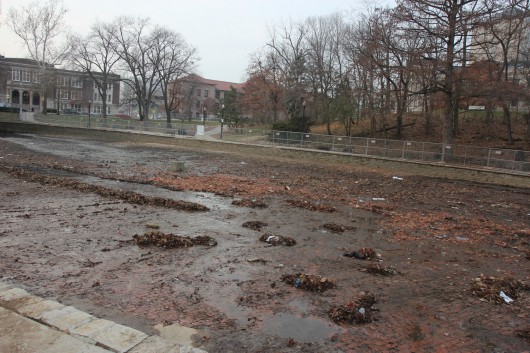
Mirror Lake was drained after the Mirror Lake jump Nov. 26 to help with cleanup efforts and to clear the area for a sustainability study.
Credit: Shelby Lum / Photo editor
Plans for Mirror Lake’s design are still in the works roughly four months after the lake was drained.
Mirror Lake was drained after the Mirror Lake jump Nov. 26. Jumping in Mirror Lake before the OSU football game against the University of Michigan is a school tradition. The lake was drained to allow for work on a sustainability study, which aims to fix a leak, find alternative sources to fill the lake and address maintenance considerations, among other goals.
As part of the next step in that sustainability study, faculty, staff, students and alumni were invited to provide feedback Thursday on design concepts for the Mirror Lake area developed using the results of the study.
An open house at Knowlton School of Architecture was held to showcase the results of the study so far and provide an opportunity for feedback from the community for those working on the project. Visual concepts and designs were presented in which attendees were then able to vote for their desired design of the shape of the lake and the surrounding landscaping.
Landscape architecture firm MKSK is working with OSU to help rebuild Mirror Lake, Courtney Keys, a project designer at MKSK, said.
Keys said about 200 people were at the forum.
“As part of looking at what we need to do to make Mirror Lake safe, beautiful and sustainable, we want to hear everybody’s input,” said Aparna Dial, director of OSU energy services and sustainability.
A series of poster boards displayed several images of potential new looks for Mirror Lake. Attendees put green stickers by the designs they preferred and red stickers by the images that did not coincide with their vision of the new lake.
The ideas and input collected from the open house are set to be used to help in the planning of the project create a master design plan for Mirror Lake and the surrounding area.
Mirror Lake became a campus fixture 140 years ago, after beginning as a small stream.
In 2002, a rock wall was built around it and a brick bottom was installed, Keys said. She added over the last few years, the lake has started to drain and constantly needs to be refilled with city water.
Keys said using city water is expensive for the university and isn’t sustainable.
At the public forum, three boards each displayed different visual preferences of potential new designs.
“The first option displayed a historical nod, the second concept showed an ethological park with open-green, wooded areas, and the last one showed a plaza aspect with hardscape and concrete,” Keys said.
The historical concepts showed the different shapes the lake has taken over the years and a timeline of how it’s developed.
“The historical imagery displayed how it’s been maintained and how it’s changed both in terms of tradition and the ethological function of it,” Keys said.
EMH&T, a Columbus-based development and public works firm, is set to conduct the sustainability study, which was slated to cost $4,520 more because extra work was added to “determine if groundwater is a viable option to feed the lake,” OSU spokeswoman for Administration and Planning Lindsay Komlanc said in a January email.
The study was set to cost $28,520, up from $24,000, she said.
The funds are slated to come from the President and Provost’s Council on Sustainability, which considers funding requests each year for various sustainability projects around campus.
The firm originally selected by OSU, EDGE Group, a local firm of landscape architects and development consultants founded by former OSU football player and assistant vice president for business advancement Eddie George, backed out of its contract to “avoid even the appearance of impropriety,” Komlanc said in an email in December.
Dial said it’s important to fix Mirror Lake’s problems to avoid wasting water.
“The United Nations predicts that by 2025, 1.8 billion people will live in absolute water scarcity and that two-thirds of the world’s population will live in a water stressed condition,” Dial said. “Just because for us, it’s an abundant resource doesn’t mean we should waste it, and the fact that we are doing something about it is really important to the university.”
Donald Boerger, a third-year in city and regional planning who attended the forum, said it’s a good idea for the lake to be restored back to its historical feel.
“It brings heritage to the campus, a sense of community and beautiful scenery that is so relaxing,” Boerger said. “People forget about heritage and history so it’s really important to bring it back to its old roots.”
Lauren Subler, a third-year in city and regional planning who attended the forum, agreed that restoring the lake back to what it used serves as a reminder.
“Since campus started around the lake and has always been the main focus, it’s good to restore it back and reminds everybody what the campus started as and where it came from,” Subler said.
The “virtual open house” opened online Thursday and is set to be available for viewing for two weeks.


